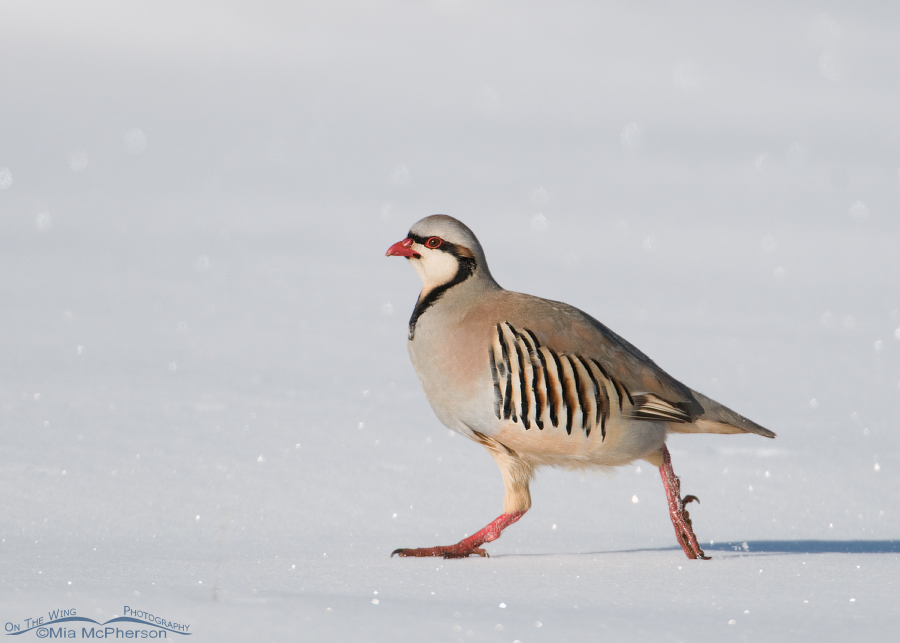 Chukar in low light – Nikon D300, f7.1, 1/800, ISO 500, +1.0 EV, Nikkor 200-400mm VR with 1.4x TC at 400mm, natural light, not baited
Chukar in low light – Nikon D300, f7.1, 1/800, ISO 500, +1.0 EV, Nikkor 200-400mm VR with 1.4x TC at 400mm, natural light, not baited
Every bird photographer should want to photograph in what is called “sweet light”, the golden light found just after the sun rises or when it is getting close to sunset and avoid the light of mid day when there can be harsh shadows and too much contrast but also recognize that other light can add a feeling of moodiness to an image that might not be there in different light.
For instance; when I look at these two snowy Chukar images I sense a moodiness in the first image that the second one doesn’t seem to convey. One of the photos was taken in bright, clear light while the other was created in low, foggy light on two different days but in the same general location on Antelope Island State Park.
In the Chukar image above I sense that the bird might be struggling to survive the harshness of winter, I get a sense of the bird being alone even though close by there were other Chukars and I also feel that the bird might be enduring a strong wind because of the tiny, directional snow drifts around the grasses near the front of the bird even though the wind was actually not blowing at the time. The low light seems to amplify the moodiness I feel while looking at this image.
 Chukar running in clear light – Nikon D300, f6.3, 1/2000, ISO 500, +0.3 EV, Nikkor 200-400mm VR with 1.4x TC at 400mm, natural light, not baited
Chukar running in clear light – Nikon D300, f6.3, 1/2000, ISO 500, +0.3 EV, Nikkor 200-400mm VR with 1.4x TC at 400mm, natural light, not baited
The snowy Chukar image above was taken on a much brighter day, there was no snow falling and no trace of fog. The habitat and terrain is essentially the same; minus the grasses seen in front of the Chukar in the image above, yet to my eyes this image does not have the moodiness the top image does.
In my mind I think more about how the Chukar survives in winter in the first image than I do in the second frame and I seem to view the image longer too.
Mia
To view more of my Chukar photos plus facts and information about this species click here.


Thanks for your comments Eileen, Ingrid,, Kathleen, Sherry, Bob, Merrill, Wally, Susan, Jane and Julie! I appreciate them very much.
Understanding the light is crucial to making great images-and you do that so well.
That is a beautiful bird in any light. But I like the tufts of grass and snow even though the eyes are darker.Although I like birds close-up I also like to see birds in their habitat.
Wonderful post of beautiful birds, I like the first photo better, but both are gorgeous. Seeing them leaves me wishing of Chukar sightings of my own
I usually study your photographs before reading your text and I did that again this time.
The words conveyed a poetry to your images that evoked exactly what I felt. Nice work!
My late husband always liked to time his photography, as you say, just after the sun rises and just before it begins to set. But to tell you the truth, often, I’ve missed a wonderfully lighted photo because I didn’t have my camera at the time and when I went back the light had changed robbing me of the one that got away. I suspect that light can be used to portray many moods… but you do seem to get the most empathic moods at those times.
I guess too, since I’m more interested in the details of something I’m photographing (I create my moods later in a painting) and my husband was more interested in the mood moving him to paint there was a difference as to what we were looking for.
You are so right, though to understand the many influences light/mood has on any photograph.
Brilliant images Mia, I love it.
I think most wildlife photogs want that sweet light so they get the most detail. I would rather see a story, which you saw in your first photo. Sometimes we are given the light we are given….not always the best but if it makes a story it is worth it.
I think it’s also anthropomorphizing the birds – in the first, the chukar is leaning, as though struggling to walk, and looking back, perhaps wistfully whereas in the second image the chukar is striding forward, there are no obstacles in the path, and the bird is looking directly ahead with its chin up – very carefree.
Your Chukars in the snow are giving me Chukar envy! Great illustration of light and setting. It’s impossible not to love these birds, the way you photograph them.
Awesome photos! Love the cool looking Chukar!